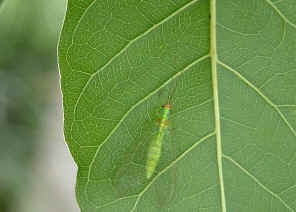|
| |
Order Neuroptera
- This page contains pictures and information about Green Lacewings in Family Chrysopidae
that
we found in the Brisbane area, Queensland, Australia.
-

- Green Lacewing larvae covered themselves with debris.
-
- Green Lacewings are small in size. Adults are bright green in
colour with clear wings and long thread-like antennae. They have relatively large,
golden, iridescent eyes. They are active at night and may come to house attracted
by
window light.
-
- Those Green Lacewings are common in Brisbane gardens and bushland.
There are many different species and they look very similar. Most of them are pale
green with clear wings and about the same size. Adults have a slow, fluttering flight.
Adults of most species are predators although some feed on nectar and
honeydew. When rest, they like to hide flat under the bottom side of leaves.
-
-



-
- Eggs were laid on long slender stalks attached on leaves or
stems. The larvae are predators to small insects, such as aphids.
Some of them covered themselves with debris. Larval stage may last several
weeks. Pupa are also covered with debris.
-
-
- Golden Eye Green Lacewing
 
- Chrysopa sp.,
subfamily Chrysopinae, adult body length 20mm, larvae length 5mm
- Green Lacewings are common in Brisbane. There are many different species
look similar, i.e., most of them are pale green with clear wings and about the
same size. Hard to identify to species level by looking at the photos. Please
check this page for more information.
-
-
- Citrus Mealybug Predator

 - Oligochrysa lutea, subfamily Apochrysinae, body length 20mm
- This Green Lacewing has very long antennae, 1.5 times of the body length.
It has board clear wings with very slight brown spots on each wings. Larvae covered themselves with debris. Eggs laid on long slender
stalks. They are common in Brisbane Eucalyptus forests. Usually found
hiding under leaves during the day. Please check this page
for more infromation.
-
- Reference:
- 1. Insects
of Australia, CSIRO, Division of Entomology, Melbourne University
Press, 2nd Edition 1991, p 539.
- 2. Insects of Australia and New Zealand - R. J. Tillyard, Angus &
Robertson, Ltd, Sydney, 1926, p318.
- 3. Wildlife
of greater Brisbane - Queensland Museum, p98.
- 4. A revision of the Australian Chrysopidae (Insecta: Neuroptera) -
TR New 1980, Aust. J. Zool. Suppl. 77: 1-143
- 5. Lacewings - Queensland Museum, 2011.
- 6. Northern
Territory Insects, A Comprehensive Guide CD - Graham Brown, 2009.
[ Up ] [ Lacewings, Antlions and Owl Flies Biology ] [ Osmylidae ] [ Mantispidae ] [ Hemerobiidae ] [ Chrysopidae ] [ Nymphidae ] [ Myrmeleontinae ] [ Stilbopteryginae ] [ Ascalaphidae ]
| |
|








